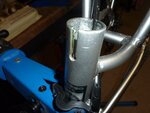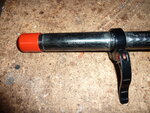6zfshdb
Well-Known Member
- Region
- USA
- City
- Northeast Pennsylvania
When putting my bike on a vehicle rack , I usually remove the seat post. This eliminates some weight, keeps the seat dry during inclement weather and prevents theft during transport. In the past, I would stuff a rag in the top of the down tube to prevent debris from entering. I learned the hard way this isn't the best idea.
After doing this for several years, the crank on my Trek MTB became stiff and started making a grinding noise. When I dismantled the crankset, I discovered the bearing case was fouled with water and fine debris. Apparently it had worked its way past the rag, traveled down the down tube and into the bearing case. For some reason, there is an opening between the down tube and the bearing case on the Trek which can allow contaminants to enter???

I'm not sure if this is the case on other bikes but I'm taking no chances with my new e-bike. I started using a plastic cap over the down tube opening.


I also use a similar cap on the seatpost end. It keeps the shim and QR clamp on the post and protects the post end & other gear from damage during transport.

After doing this for several years, the crank on my Trek MTB became stiff and started making a grinding noise. When I dismantled the crankset, I discovered the bearing case was fouled with water and fine debris. Apparently it had worked its way past the rag, traveled down the down tube and into the bearing case. For some reason, there is an opening between the down tube and the bearing case on the Trek which can allow contaminants to enter???

I'm not sure if this is the case on other bikes but I'm taking no chances with my new e-bike. I started using a plastic cap over the down tube opening.


I also use a similar cap on the seatpost end. It keeps the shim and QR clamp on the post and protects the post end & other gear from damage during transport.


